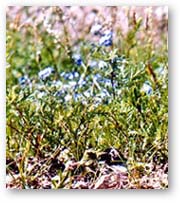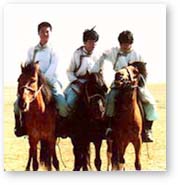|
1. Forget-me-nots
The city is overflowing with flowers.
While it is always a joy to see carefully and lovingly cultivated flowers blossom, it is perhaps even more endearing to see wild flowers blooming in the wilderness as they cling bravely to the earth.
When I look upon the forget-me-nots in my garden, whose stalks and flowers seem tender enough to eat, I remember the forget-me-nots of the Inner Mongolian Plain.
Forget-me-nots (myosotis scorpioides L.) are known as wasurenagusa in Japanese, wu wang cao in Chinese and vergissmeinnicht in German, which all have the same meaning.
Once, long ago, a youth saw a blue flower at the edge of a steep cliff. He wanted very much to pick the flower to give his lover, but when he tried to do so, he slipped and fell into the river below. His last words to his lover were "Forget me not!" as he threw the flower to her before being carried away in the violent current.

Copyright1998 Keiko Andou |
When, as a child, I first heard this old German folk story, I immediately fell in love with the blue flowers of the forget-me-not.
During my travels to the Inner Mongolia Plain in China one July, I unexpectedly ran across a large bed of forget-me-nots.
I had traveled an hour and a half from Beijing, arriving at Huhehaote, the capital of the Autonomous Region of Inner Mongolia,and then traveled another hour and a half by plane to Xilinhaote in the center of the plain. Finally, after three hours by jeep, I reached the farthest part of the plain, 1,400 meters above sea level, where I stayed the night in a pao (a traditional Mongolian mobile house made of woven animal hair).
Although I had imagined a plain with grasses swaying in the wind, what I saw insteadwas a virgin flower bed, with flowers standing 4 to 5 centimeters in height, and which continued as far as the eye could see.
It looked as if the heavens had sown the seeds of all the world's mountain plants inthis very spot.
Of the more than 1,000 varieties of plantshere, I was told that 500 are valuable plants for Chinese herbal medicine.
As I look out across the rolling hills which spread endlessly under the blue sky, sheep and horses graze on the plain and birds sing out in competition with each other.

Copyright1998 Setsuko Watanabe |
Throughout the village, I am welcomed withhada and an alcoholic drink made from horses' milk, while sumo matches and horse races are held on the plain.
The people of the Inner Mongolian Plain, descendants of Genghis Khan, certainly treat their guests well.
The pao is surrounded on all sides by a flower bed of forget-me-nots. The delicate flowers look as if they might disappear into the air, but if you touch them, you willfind they are as hard as wire- a defense against the severe cold, dryness and winds of the plains.
About the same size as spiderworts, the flowers are a clear, deep blue like sapphires. It looks as if someone has gathered allthe light from the stars above the plain and condensed it.
In the pure, fresh air of this northern country, blue flowers stand out the most vividly and beautifully.
When I asked the hotel maid the names of flowers in Mongolian, she told me that theywere all called chechek. Because flowers bloom only once a year and for one short month, they do not have individual names. However, it is popular to name girls after the precious and beautiful flowers. In fact, she told me her name was Naranchechek (flower of the sun).
Copyright1998 Setsuko Watanabe
|



